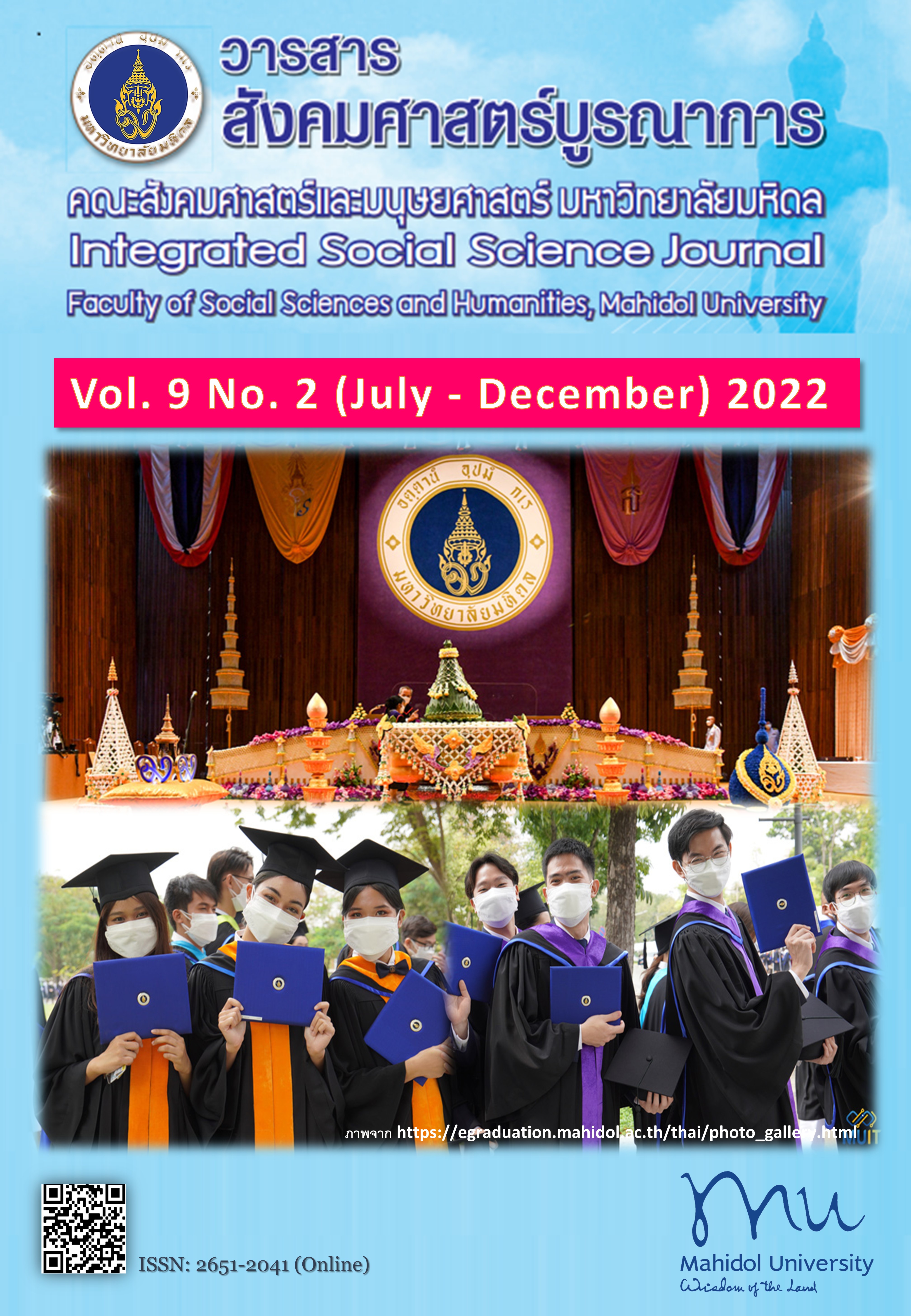ประสิทธิผลของการเรียนการสอนแบบห้องเรียนกลับด้านผ่านการเรียนรู้ออนไลน์ ในรายวิชา IST20 1003 ทักษะชีวิต ของนักศึกษามหาวิทยาลัยเทคโนโลยีสุรนารี ในช่วงการแพร่ระบาดของเชื้อไวรัสโควิด-19
Main Article Content
บทคัดย่อ
การศึกษานี้มีวัตถุประสงค์เพื่อศึกษาความชอบของนักศึกษาที่มีต่อรูปแบบการเรียนแบบดั้งเดิม (Conventional Learning Method) และแบบห้องเรียนกลับด้าน (Flipped Classroom) และ ศึกษาประสิทธิผลของการเรียนรู้แบบห้องเรียนกลับด้าน การศึกษานี้เป็นการวิจัยกึ่งทดลอง ดำเนินการในชั้นเรียนรายวิชา IST20 1003 ทักษะชีวิต โดยผู้วิจัยได้จัดการเรียนการสอนแบบห้องเรียนกลับด้าน และวัดประเมินประสิทธิผลของการเรียนรู้ เครื่องมือที่ใช้ในการเก็บรวบรวมข้อมูล ได้แก่ แบบสอบถาม และ แบบทดสอบก่อน-หลังการเรียน โดยประชากรในการศึกษานี้ ได้แก่ นักศึกษามหาวิทยาลัยเทคโนโลยีสุรนารีที่ลงทะเบียนเรียนรายวิชา IST20 1003 จำนวน 1,553 คน และ มีนักศึกษาสมัครใจเข้าร่วมวิจัย จำนวนทั้งสิ้น 1,176 คน สถิติที่ใช้วิเคราะห์ข้อมูล ประกอบด้วย สถิติเชิงพรรณนา และสถิติเชิงอ้างอิง ได้แก่ Paired-sample t-test, Independent Sample t-test, และ การวิเคราะห์ความแปรปรวน และเปรียบเทียบรายคู่ด้วย Fisher's LSD Post Hoc Test ผลการศึกษา พบว่า (1) นักศึกษาชอบการจัดการเรียนการสอนแบบห้องเรียนกลับด้าน มากกว่าการเรียนแบบดั้งเดิม เนื่องจากห้องเรียนกลับด้าน (1.1) มีเนื้อหาเน้นการปฏิบัติจริงและแก้ไขปัญหา (1.2) มีเทคโนโลยีช่วยในการเรียนรู้ (1.3) มีส่วนร่วมในการเรียน และการมีปฏิสัมพันธ์ระหว่างเรียนได้ตลอดเวลา และ (1.4) มีสื่อการสอน ที่ใช้เตรียมตัวก่อนเข้าเรียน และสามารถนำความรู้ไปใช้ได้จริงและเน้นการแก้ปัญหา (2) ผลการเปรียบเทียบคะแนนสอบก่อน-หลังของการเรียนแบบห้องเรียนกลับด้าน พบว่า คะแนนสอบหลังการเรียนสูงกว่าคะแนนสอบก่อนการเรียน อย่างมีนัยสำคัญทางสถิติ (3) หลังเสร็จสิ้นการเรียนการสอนแบบห้องเรียนกลับด้าน พบว่า นักศึกษาเพศหญิงมีทัศนคติเชิงบวกระหว่างการเรียนในห้องเรียนกลับด้านสูงกว่าเพศชาย อย่างมีนัยสำคัญทางสถิติ และ นักศึกษาชั้นปีที่ 1 มีทัศนคติก่อนการเรียนแบบห้องเรียนกลับด้าน และมีระดับความผูกพันในการเรียนแบบกลับด้านสูงกว่านักศึกษาชั้นปีอื่น ๆ อย่างมีนัยสำคัญทางสถิติ และ (4) นักศึกษาในกลุ่มสำนักวิชาวิทยาศาสตร์สุขภาพและวิศวกรรมศาสตร์มีทัศนคติเชิงบวกต่อการเรียนแบบห้องเรียนกลับด้านสูงกว่านักศึกษาจากกลุ่มสำนักวิชาวิทยาศาสตร์, เทคโนโลยีการเกษตร, และเทคโนโลยีสังคม อย่างมีนัยสำคัญทางสถิติ ผลการศึกษาที่ได้ชี้ให้เห็นถึงประสิทธิผลของการนำเทคโนโลยีและวิธีการเรียนรู้แบบใหม่เข้ามาใช้ในการจัดการเรียนการสอนแก่นักศึกษา โดยเฉพาะในช่วงสถานการณ์การแพร่ระบาดของเชื้อไวรัสโควิด-19
Article Details

อนุญาตภายใต้เงื่อนไข Creative Commons Attribution-NonCommercial-NoDerivatives 4.0 International License.
- วารสารสังคมศาสตร์บูรณาการ มหาวิทยาลัยมหิดล อนุญาตให้สามารถนำไฟล์บทความไปใช้ประโยชน์และเผยแพร่ต่อได้ โดยอยู่ภายใต้เงื่อนไขสัญญาอนุญาต CC Attribution-NonCommercial-NoDerivatives 4.0 International (CC BY-NC-ND 4.0) โดยต้องแสดงที่มา/การอ้างอิงจากวารสาร – ไม่ใช้เพื่อการค้า – ห้ามแก้ไขดัดแปลงเนื้อหา
- ข้อความที่ปรากฏในบทความในวารสารฯ เป็นความคิดเห็นส่วนตัวของผู้เขียนแต่ละท่าน ไม่เกี่ยวข้องกับกองบรรณาธิการวารสารฯ (ซึ่งหมายรวมถึง บรรณาธิการ ผู้ทรงคุณวุฒิในกองบรรณาธิการ หรือ บรรณาธิการรับเชิญ) แต่อย่างใด ความรับผิดชอบองค์ประกอบทั้งหมดของบทความแต่ละเรื่องเป็นของผู้เขียนแต่ละท่าน หากมีความผิดพลาดใด ๆ ผู้เขียนแต่ละท่านจะรับผิดชอบบทความของตนเอง ตลอดจนความรับผิดชอบด้านเนื้อหาและการตรวจร่างบทความเป็นของผู้เขียน ไม่เกี่ยวข้องกับกองบรรณาธิการวารสารฯ
- กองบรรณาธิการขอสงวนสิทธิ์ในการตัดทอน/ปรับแก้ถ้อยคำบางประการเพื่อความเหมาะสม
เอกสารอ้างอิง
Abeysekera, L., & Dawson, P. (2015). Motivation and cognitive load in the flipped classroom: Definition, rationale, and a call for research. Higher Education Research & Development, 34(1), 1-14.
Bergmann, J., & Sams, A. (2012). Flip your classroom: Reach every student in every class every day. International Society for Technology in Education.
Betihavas, V., Bridgman, H., Kornhaber, R., & Cross, M. (2016). The evidence for ‘flipping out’: A systematic review of the flipped classroom in nursing education. Nurse Education Today, 38, 15-21.
Boonphak, K. (2020). Learning management in the new normal. Journal of Industrial Education, 19(2), 1-6.
Brame, C. (2013). Flipping the classroom. Vanderbilt University Center for Teaching.
Campillo-Ferrer, J. M., & Miralles-Martínez, P. (2021). Effectiveness of the flipped classroom model on students’ self-reported motivation and learning during the COVID-19 pandemic. Humanities and Social Sciences Communications, 8(17), 1-9.
Clark, K. R. (2013). Examining the effects of the flipped model of instruction on student engagement and performance in the secondary mathematics classroom: An action research study (Doctoral Dissertation), Capella University.
Dale, E. (1969). Audio visual method in teaching (4th ed). Holt Rinehart and Winston Inc.
Dumford, A. D., & Miller, A. L. (2018). Online learning in higher education: Exploring advantages and disadvantages for engagement. Journal of Computing in Higher Education, 30(3), 452-465.
Gilboy, M. B., Heinerichs, S., & Pazzaglia, G. (2015). Enhancing student engagement using the flipped classroom. Journal of Nutrition Education and Behavior, 47(1), 109-114.
Herreid, C. F., & Schiller, N. A. (2013). Cade studies and the flipped classroom. Journal of College Science Teaching, 42(5), 62-66.
Irawan, A. W., Dwisona, D., & Lestari, M. (2020). Psychological impacts of students on online learning during the pandemic COVID-19. KONSELI: Jurnal Bimbingan dan Konseling, 7(1), 53-60.
Love, B., Hodge, A., Grandgenett, N., & Swift, A. W. (2014). Student learning and perceptions in a flipped linear algebra course. International Journal of Mathematical Education in Science and Technology, 45(3), 317-324.
McNally, B., Chipperfield, J., Dorsett, P., Del Fabbro, L., Frommolt, V., Goetz, S., ... & Rung, A. (2017). Flipped classroom experiences: Student preferences and flip strategy in a higher education context. Higher Education, 73(2), 281-298.
Nouri, J. (2016). The flipped classroom: For active, effective and increased learning–especially for low achievers. International Journal of Educational Technology in Higher Education, 13(1), 1-10.
Nunnally, J. C. (1978). Psychometric theory (2nd ed.). McGraw-Hill.
Pandam, S. (2020). New approach of learning of vocational education in post-COVID-19. T-VET Journal, 4(7), 4-16.
Phanthai, B. (2017). Preliminary study research methodology (In Thai). Ramkhamhaeng University Press.
Phumpuang, K., & Sittiwong, T. (2018). The development of flipped classroom learning activities with collaborative learning approach for undergraduate students. Journal of Education Naresuan University, 20(2), 1-11.
Raitskaya, L., & Tikhonova, E. (2019). Skills and competencies in higher education and beyond. Journal of Language and Education, 5(4), 4-8.
Rovinelli, R. J., & Hambleton, R. K. (1977). On the use of content specialists in the assessment of criterion-referenced test item validity. Tijdschrift voor Onderwijsresearch, 2(2), 49–60
Sahu, P. (2020). Closure of universities due to coronavirus disease 2019 (COVID-19): Impact on education and mental health of students and academic staff. Cureus, 12(4), e7541.
Sangsawangwatthana, T., Sirisaiyas, N., & Bodeerat, C. (2020). “New normal” a new way of life and adaptation of Thai people after COVID-19: Work education and business. Journal of Local Governance and Innovation, 4(3), 371-386.
Santiago, B. J., Ramirez, J. M. O., Rodriguez-Resendiz, J., Dector, A., Garcia, R. G., Gonzalez-Duran, J. E. E., & Sanchez, F. F. (2020). Learning management system-based evaluation to determine academic efficiency performance. Sustainability, 12(10), 1-17.
Schaufeli, W. B., Bakker, A. B., & Salanova, M. (2006). The measurement of work engagement with a short questionnaire: A cross-national study. Educational and Psychological Measurement, 66(4), 701-716.
Sithsungnoen, C. (2017). Flipped classroom: Learning skill in century 21st. Journal of MCU Social Science Review, 6(2), 171-182.
Suwanno, P., & Lumbensa, P. (2019). Effects of a flipped-classroom model with research-based learning of the fourth-year students at Yala Rajabhat University. Journal of Yala Rajabhat University, 14(1), 1-10.
Szparagowski, R. (2014). The effectiveness of the flipped classroom. Bowling Green State University.
Thummakul, D., & Pongkiachai, R. (2022). Development of learning outcomes of nursing students by using the flipped classroom in research and innovation subject. Princess of Naradhiwas University Journal, 14(2), 193-214.
Trilling, B., & Fadel, C. (2009). 21st century skills: Learning for life in our times. John Wiley & Sons.
Zainuddin, Z., & Halili, S. H. (2016). Flipped classroom research and trends from different fields of study. International Review of Research in Open and Distributed Learning, 17(3), 313-340.


